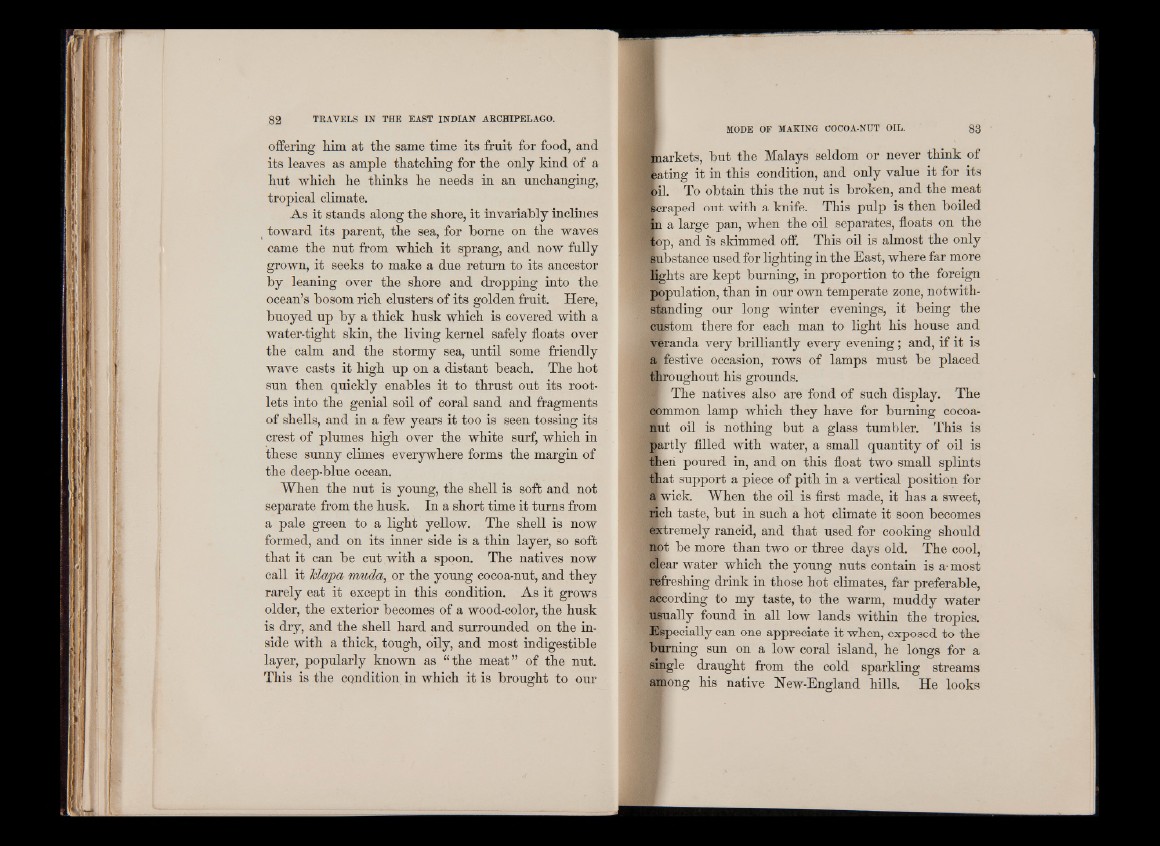
offering him at the same time its fruit for food, and
its leaves as ample thatching for the only kind of a
hut which he thinks he needs in an unchanging,
tropical climate.
As it stands along the shore, it invariably inclines
toward its parent, the sea, for borne on the waves
came the nut from which it sprang, and now folly
grown, it seeks to make a due return to its ancestor
by leaning over the shore and dropping into the
ocean’s bosom rich clusters of its golden fruit. Here,
buoyed up by a thick husk which is covered with a
water-tight skin, the living kernel safely floats over
the calm and the stormy sea, until some friendly
wave casts it high up on a distant beach. The hot
sun then quickly enables it to thrust out its rootlets
into the genial soil of coral sand and fragments
of shells, and in a few years it too is seen tossing its
crest of plumes high over the white surf, which in
these sunny climes everywhere forms the margin of
the deep-blue ocean.
When the nut is young, the shell is soft and not
separate from the husk. In a short time it turns from
a pale green to a light yellow. The shell is now
formed, and on its inner side is a thin layer, so soft
that it can be cut with a spoon. The natives now
call it Tdapa muda, or the young cocoa-nut, and they
rarely eat it except in this condition. As it grows
older, the exterior becomes of a wood-color, the husk
is dry, and the shell hard and surrounded on the inside
with a thick, tough, oily, and most indigestible
layer, popularly known as “ the meat” of the nut.
This is the condition in which it is brought to our
MODE OF MAKING COCOA-NUT OIL. 83
Inarkets, but the Malays seldom or never think of
pating it in this condition, and only value it for its
oil. To obtain this the nut is broken, and the meat
»craped out with a knife. This pulp is then boiled
in a large pan, when the oil separates, floats on the
lop, and is skimmed off. This oil is almost the only
substance used for lighting in the East, where far more
lights are kept burning, in proportion to the foreign
population, than in our own temperate zone, notwithstanding
our long winter evenings, it being the
custom there for each man to light his house and
veranda very brilliantly every evening; and, if it is
a festive occasion, rows of lamps must be placed
throughout his grounds.
f The natives also are fond of such display. The
common lamp which they have for burning cocoa-
nut oil is nothing but a glass tumbler. This is
partly filled with water, a small quantity of oil is
then poured in, and on this float two small splints
that support a piece of pith in a vertical position for
alwick. When the oil is first made, it has a sweet,
rich taste, but in such a hot climate it soon becomes
fctremely rancid, and that used for cooking should
not be more than two or three days old. The cool,
clear water which the young nuts contain is a- most
refreshing drink in those hot climates, far preferable,
according to my taste, to the warm, muddy water
usually found in all low lands within the tropics.
Specially can one appreciate it when, exposed to the
bftming sun on a low coral island, he longs for a
single draught from the cold sparkling streams
among his native New-England hills. He looks